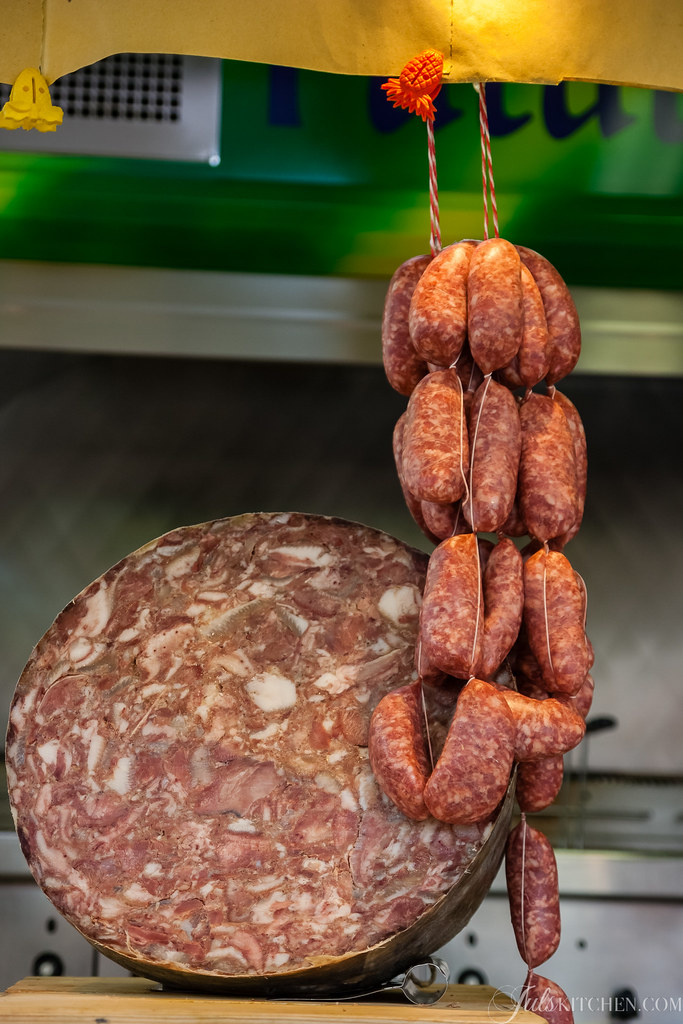Listen to your butcher. Chickpea crostoni, two ways.
The typical cold cuts of my area, that hilly shire that stretches in between Siena and Florence, among the vineyards and olive groves of Chianti and farmhouses and white roads of Valdelsa, are anything but refined. Forget paper-thin slices of ham. Here you find buristo. Here you find soppressata. Here you find the boiled pork chick, cured with balsamic spices as juniper, a specialty that can be found only at my butcher and at a few other specialized shops.
Obviously the Tuscan prosciutto has a special place in our hearts, and if you are a true Tuscan you would eat it all, including the fat as you know, that’s the best part, where the flavour is, where you can recognize a skillfully cured ham from a hastily done one.

But the old people who have behind them a life of choices and heavy work in the fields or simply in the sloping vegetable gardens outside the city walls, with huts built with scraps good to shelter just two buckets and a few seeds, those old men know what to choose when they scan the butcher’s counter: finocchiona, sbriciolona, soppressata or buristo. My grandfather Remigio was just like these old men, he taught me to be brave and try everything and to appreciate the joy of having some soppressata with a slice of plain Tuscan bread.

When you stroll in a Tuscan market among the food stalls you’ll recognize those grand wheels of soppressata. The vendors artfully display them to capture your attention: a Renaissance painting, a huge soppressata and a line of sausages ripe enough to be spread on bread and roasted on fire. Their intoxicating smell pervades the air and catches your eye, a sensuous spell, your senses guide your choices.
When you’re at the butcher’s, however, let senses guide you, but pay attention to his talks, too. I’ve always been lucky enough to meet butchers which were jovial and talkative, who do not sell you just a good piece of meat, but also interesting ideas to cook it, to use the less valued cuts, to impress your mother-in-low at dinner even if your culinary skills do not pass a fried egg.
When at the butcher’s pay attention to the chatter of the old ladies queuing up next to you, as they can not resist, they crave to tell you how they make the roast, or how superb their Sunday spread for crostini with rabbit liver and ground meat is.
If you go to my butcher, Luciano, you’ll always find a crammed little shop, as he is by all accounts the best butcher in the area. Trust him when he says that a recipe works, you can make it for the first time for dinner when his colleagues are invited and serve it without risking to eat a shoe insole.
Some time ago I was in line eavesdropping on grandmothers’ chatter next to me, carefully filtering out the talks about their grandchildren to find traces of recipes, when Luciano leant over the counter to tell me about a recipe that he learnt from a local gourmand who had been invited at dinner in the Chianti area.
The premises captured my attention. It is a crostone, a topped slice of bread, nothing more simple. If you have leftover chickpeas you just toss them in the pan with a drop of good extra virgin olive oil and a thick slice of soppressata, diced. Extraordinary in its simplicity. It is apparently a typical starter in the Chianti area, but it is so localized that it doesn’t get through those hills covered by vineyards.


By chance I had a pot of leftover chickpeas, as I usually cook for a yesteryear matriarchal family although we are at most two at the table. From that chickpeas to heat a cast iron skillet to try those crostoni the step was short. And with the rest of the chickpeas I made some crostoni with artichokes and calamint.
Together they can be a quick dinner for two that you can set up in twenty minutes while you wear more comfortable clothes and decide which movie to watch on the sofa. They can also lend to open a dinner with friends, when you’d better start with something filling to appease the appetites of those who come into the kitchen to see if the water for the pasta is boiling, as during the journey from Florence the hunger has grown and the impatience presses. Do you have friends like that? I do, and honestly they are the ones that I like to have at the table!

My butcher’s crostoni
The recipe was simple: just a slice of toasted bread, chickpeas and soppressata. I threw in also some thinly sliced orange zest, as orange is one of the aromas you can find in a soppressata. With the heat from the skillet the orange releases its essence and makes it an even brighter dish.
Crostoni with chickpeas and soppressata
Print Recipe Pin Recipe Share by EmailIngredients
- 1 cup of chickpeas, already cooked and drained
- 1/2 cup of soppressata, diced
- Extra virgin olive oil
- Salt
- Freshly ground black pepper
- Zest of 1/2 organic orange
- 4 slices of bread, toasted
Instructions
- Pour a tablespoon of olive oil in the skillet. This time, don't be too generous, otherwise you will end up with a heavy dish as the soppressata will release some of its fat while cooking.
- Add the chickpeas and warm them up on medium heat. Add also the thinly sliced orange zest and the diced soppressata. Cook the chickpeas until the soppressata will begin to surrender to the fire.
- Season with salt and pepper and scoop the chickpeas over the toasted slices of bread. If it looks too dry add a final drizzle of olive oil. Let rest for a few minutes then enjoy your crostoni.
Chickpea crostoni with artichokes and calamint
Calamint is a wild herb that usually grows next to the walls or in the fields. It teams up nicely with mushrooms in autumn and eggplants in summer. If you can not find it, replace it with wild mint. Lemon juice, which pairs beautifully with artichokes, makes the chickpeas livelier.
Chickpea and artichoke crostoni
Print Recipe Pin Recipe Share by EmailIngredients
- 2 artichokes
- 1 clove of garlic
- Extra virgin olive oil
- 1 lemon
- Salt
- Freshly ground black pepper
- 1 cup of chickpeas, already cooked and drained
- A few sprigs of mint or calamint
- 4 slices of bread, toasted
Instructions
- Clean the artichokes and slice them thinly, rubbing them with lemon to prevent them turning black.
- Warm a clove of garlic in a pan with a few tablespoons of olive oil. As soon as it becomes fragrant add the artichokes and let them simmer for about ten minutes, stirring often and adding some lemon juice.
- When the artichokes are tender add the chickpeas and cook them until flavoured and warm. Season with salt and pepper and add a few sprigs of calamint.
- Toast the slices of bread and spoon the artichokes and chickpeas generously over each slice. Drizzle with olive oil. Allow the crostoni about ten minutes so bread will be soaked with the juices, then serve with a few lemon slices.

Link Love
- Speaking of alternative ways to cook with Tuscan cold cuts, long ago I blogged about buristo and a typical way of serving it here in Valdelsa, with a fried egg. The penetrating smell of buristo cooked in a pan, its spicy taste softened by the runny egg yolk: the closest thing to heaven.
- If you are intrigued by calamint, here I used it in combination with dried mushrooms for a Sunday fresh pasta dish. Emiko used it for braised artichokes.
- Now more on the soppressata. It is a cooked cold cut made with leftover parts of pork as rinds, cartilage, head and tongue: they are all chopped and pressed in sackcloth. It is flavoured with spices and orange zest. It is similar to the English brawn. More on soppressata and other cold cuts here. Serena is instead showing another typical recipe to use soppressata as an appetizer, a salad with orange and olives.
Food of Florence
I am proud to show you a video Tommaso made for a workshop. This is just the beginning of even more exciting adventures with him and a camera searching for good food to share with you!










This looks delicious! Could these 2 recipes be combined ? if i were to make an artichoke soppressata chickpea salad… thanks! love y our blog so much.
hello Ashley, sure you can, it’s actually a brilliant idea!
I made the chickpea and soppressata crostoni last night and they were delicious! So easy too, and I would never have thought of combining them. I’ve been meaning to make them since you posted this, and remembered them out of the blue when I wanted an appetizer for our impromptu company. Thank you!
wow Gabrielle, you have a good memory! 🙂 so happy you liked the combination, and my butcher will be super proud to know that this recipe is still loved!